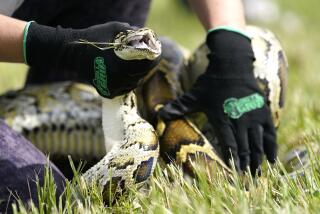ECOLOGY : Manatees’ Darkening Shadows : Florida’s beloved water mammals are dying at alarming rates. Their fate depends largely on human activity.
- Share via
MIAMI — Nothing brings manatees together like a cold snap.
Deep in the sunny dead-end of an inland canal--not 30 yards from the nonstop traffic along U.S. 1--eight of the hulking mammals hung in the water like aquamaids on a rehearsal break.
“Are they mating?” asked a customer of a bank’s walk-up window, which overlooks the canal.
“No,” replied county biologist Keven Eileen Mayo, making a periodic check on the herd, “they’re just staying warm. And staying alive.”
The homely manatee may be among the best-loved animals in Florida--its picture is on a fund-raising license plate--but it is also a creature shadowed by extinction. And the shadow is darkening.
So far this year, 47 manatees have been found dead in Florida--double the rate at this time last year, when a total of 192 perished. Meanwhile, an aerial survey last month turned up a smaller than expected head count. At a time when the entire U.S. population of West Indian manatees can be found in Florida’s warm waters, researchers spotted only 1,443 of the animals--down from a high of 1,856 three years ago.
The high mortality rate and the low population estimate have alarmed scientists. “Unlike the extreme cold temperatures in 1990--the highest single year for manatee mortality, with 206 deaths--no single, large natural event occurred in 1994 to which we can attribute the high mortality,” said Pat Rose of the Florida Department of Environmental Protection.
More than 20 years after it was officially listed as an endangered species and given federal protection, the manatee’s fate still rests in the balance between preserving natural ecosystems and meeting the desires of people. Most manatee deaths result from collisions with boats and propellers, getting crushed in flood-control gates and from unknown causes that produce a high infant mortality rate.
A spate of adult female deaths has left a record number of manatee orphans unable to fend for themselves. Seven orphans are being cared for at the Miami Seaquarium, where veterinarian Greg Bossart lamented, “We’re killing off the species.”
There are a few hopeful signs. “The good news is that 11 Florida coastal counties have protected thousands of miles of waterways with go-slow zones,” said Judith Vallee, executive director of the 38,000-member Save the Manatee Club. “The bad news, however, is that manatees are still dying because the waterways are unsafe, and the state has relied on voluntary compliance of the speed laws.”
In fact, the state has barely 500 marine patrol officers to enforce the boating laws over thousands of miles of fresh- and saltwater, and manatees may not rate the highest law enforcement priority. Although boaters indicate in surveys their affection for the manatee, many also say they are reluctant to reduce speeds just to avoid hitting one.
Manatees also are threatened by pollution and turbidity that impede the growth of plants on which they feed.
A distant cousin of the elephant, manatees can reach a length of 12 feet and weigh up to 3,500 pounds. They are agile swimmers at home in fresh- and saltwater. They subsist on sea grass and propel themselves through the water by flapping their broad, flat tail. One of four living species of the order Sirenia, the West Indian manatee’s habitat ranges from northeastern South America to--in the summer--as far north as the Carolinas.
During the winter months, herds of manatees gather at about 24 warm-water refuges in Florida, including the outflow of several electrical power plants.
Mayo, coordinator of Dade County’s Manatee Protection Program, said: “We will have to make changes in our lifestyle if we want them to survive.”
Manatees, in turn, could have a bearing on human survival.
Bossart, a pathologist and immunologist, says his research indicates that the manatee’s blood--with a high level of disease-fighting T-cells--may explain the animal’s ability to survive traumatic injury. “I’ve had one live after being almost cut in half by a boat propeller . . . . “ he said.
“But their death at human hands is a very disturbing trend.”
Times researcher Anna M. Virtue contributed to this story.
More to Read
Sign up for Essential California
The most important California stories and recommendations in your inbox every morning.
You may occasionally receive promotional content from the Los Angeles Times.













